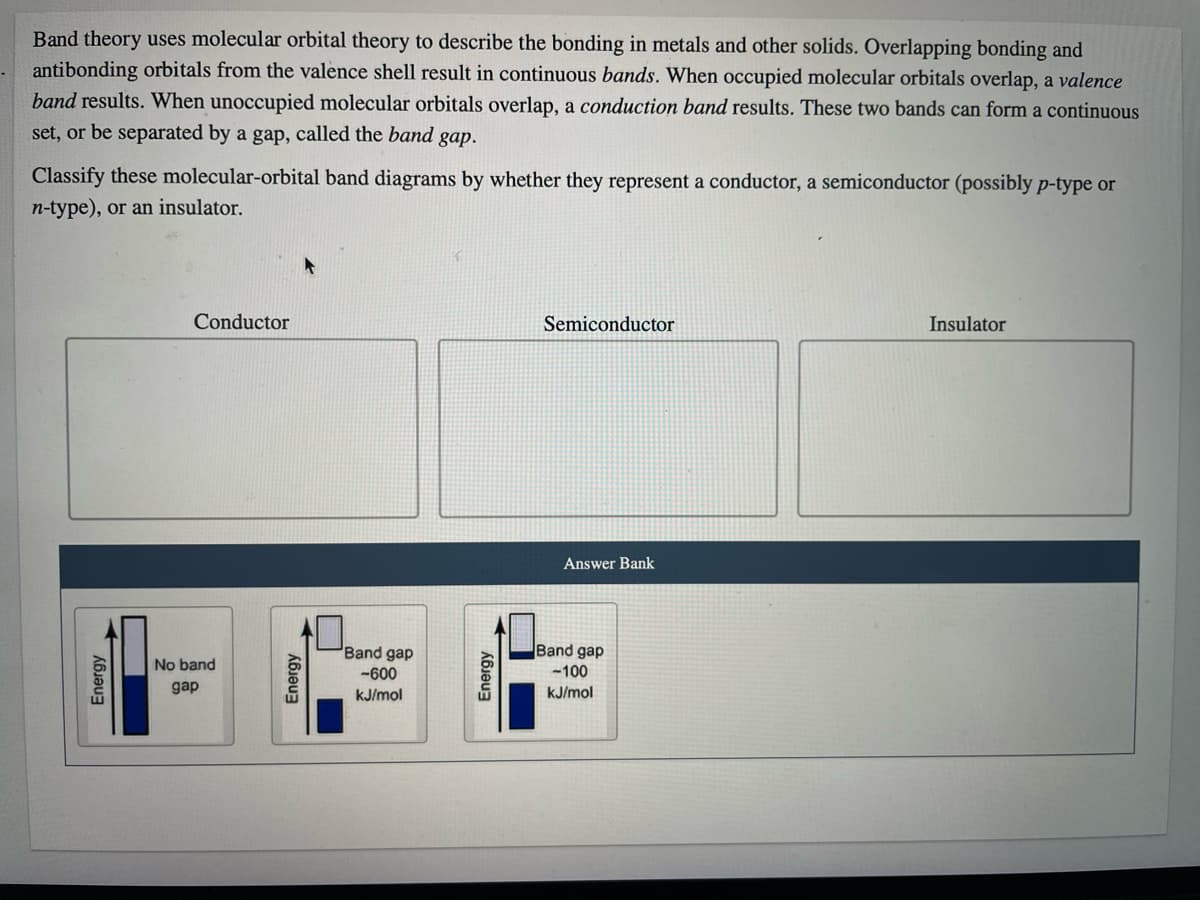Band theory uses molecular orbital theory to describe the bonding in metals and other solids. Overlapping bonding and antibonding orbitals from the valence shell result in continuous bands. When occupied molecular orbitals overlap, a valence band results. When unoccupied molecular orbitals overlap, a conduction band results. These two bands can form a continuous set, or be separated by a gap, called the band gap. Classify these molecular-orbital band diagrams by whether they represent a conductor, a semiconductor (possibly p-type or n-type), or an insulator. Conductor Semiconductor Insulator Answer Bank
Band theory uses molecular orbital theory to describe the bonding in metals and other solids. Overlapping bonding and antibonding orbitals from the valence shell result in continuous bands. When occupied molecular orbitals overlap, a valence band results. When unoccupied molecular orbitals overlap, a conduction band results. These two bands can form a continuous set, or be separated by a gap, called the band gap. Classify these molecular-orbital band diagrams by whether they represent a conductor, a semiconductor (possibly p-type or n-type), or an insulator. Conductor Semiconductor Insulator Answer Bank
Chemistry for Engineering Students
4th Edition
ISBN:9781337398909
Author:Lawrence S. Brown, Tom Holme
Publisher:Lawrence S. Brown, Tom Holme
Chapter8: Molecules And Materials
Section: Chapter Questions
Problem 8.97PAE: 8.97 The doping of semiconductors can be done with enough precision to tune the size of the band gap...
Related questions
Question
How do I solve this?

Transcribed Image Text:Band theory uses molecular orbital theory to describe the bonding in metals and other solids. Overlapping bonding and
antibonding orbitals from the valence shell result in continuous bands. When occupied molecular orbitals overlap, a valence
band results. When unoccupied molecular orbitals overlap, a conduction band results. These two bands can form a continuous
set, or be separated by a gap, called the band gap.
Classify these molecular-orbital band diagrams by whether they represent a conductor, a semiconductor (possibly p-type or
n-type), or an insulator.
Conductor
Semiconductor
Insulator
Answer Bank
Band gap
Band gap
No band
-600
-100
gap
kJ/mol
kJ/mol
Energy
Energy
Energy
Expert Solution
This question has been solved!
Explore an expertly crafted, step-by-step solution for a thorough understanding of key concepts.
This is a popular solution!
Trending now
This is a popular solution!
Step by step
Solved in 2 steps with 1 images

Knowledge Booster
Learn more about
Need a deep-dive on the concept behind this application? Look no further. Learn more about this topic, chemistry and related others by exploring similar questions and additional content below.Recommended textbooks for you

Chemistry for Engineering Students
Chemistry
ISBN:
9781337398909
Author:
Lawrence S. Brown, Tom Holme
Publisher:
Cengage Learning

Chemistry & Chemical Reactivity
Chemistry
ISBN:
9781337399074
Author:
John C. Kotz, Paul M. Treichel, John Townsend, David Treichel
Publisher:
Cengage Learning

Chemistry & Chemical Reactivity
Chemistry
ISBN:
9781133949640
Author:
John C. Kotz, Paul M. Treichel, John Townsend, David Treichel
Publisher:
Cengage Learning

Chemistry for Engineering Students
Chemistry
ISBN:
9781337398909
Author:
Lawrence S. Brown, Tom Holme
Publisher:
Cengage Learning

Chemistry & Chemical Reactivity
Chemistry
ISBN:
9781337399074
Author:
John C. Kotz, Paul M. Treichel, John Townsend, David Treichel
Publisher:
Cengage Learning

Chemistry & Chemical Reactivity
Chemistry
ISBN:
9781133949640
Author:
John C. Kotz, Paul M. Treichel, John Townsend, David Treichel
Publisher:
Cengage Learning

Principles of Modern Chemistry
Chemistry
ISBN:
9781305079113
Author:
David W. Oxtoby, H. Pat Gillis, Laurie J. Butler
Publisher:
Cengage Learning

Chemistry: The Molecular Science
Chemistry
ISBN:
9781285199047
Author:
John W. Moore, Conrad L. Stanitski
Publisher:
Cengage Learning